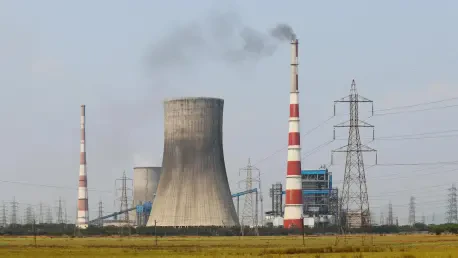What happens when a nation’s hunger for energy clashes with its promise to go green? India, home to over 1.4 billion people, faces an escalating electricity demand that threatens to outstrip supply, with evening power needs spiking as air conditioners hum across urban centers, and despite bold commitments to renewable energy, states are signing massive coal power deals. This raises a critical question: can India balance its economic ambitions with a sustainable future? This dilemma unfolds as a stark reminder of the tension between immediate needs and long-term goals.
The Stakes of an Energy-Hungry Nation
India’s rapid economic growth has positioned it as one of the world’s fastest-growing economies, but this progress comes at a steep price: an electricity demand that’s surging beyond current capacity. As the third-largest greenhouse gas emitter globally, the nation has pledged to expand non-fossil fuel capacity to 500 gigawatts by 2030, nearly doubling the existing 251.4 gigawatts. Yet, the reality on the ground tells a different story, with states scrambling to secure reliable power sources to prevent blackouts during peak hours, particularly in densely populated regions.
This struggle is not just about numbers; it’s about the lives and livelihoods that depend on a stable grid. With urbanization driving up the use of energy-intensive appliances, evening demand has become a persistent challenge. Renewable sources like solar falter after sunset, exposing gaps in the system that threaten industrial output and domestic comfort. The urgency to address this shortfall has pushed policymakers into a corner, where short-term fixes often overshadow long-term visions.
Why Coal Remains King in a Renewable Era
Despite global pushes toward cleaner energy, India’s reliance on coal is witnessing a striking resurgence. Over the past 16 months, a pipeline of over 17 gigawatts of coal-fired power contracts has emerged—the largest since the pandemic hit. States like Uttar Pradesh and Assam are leading the charge, planning to lock in at least 7 gigawatts by 2030, driven by the need for a steady base load that renewables currently struggle to provide without adequate storage solutions.
The paradox lies in the slow rollout of supporting infrastructure for clean energy. Battery storage, crucial for stabilizing renewable supply, lags far behind targets, with only 219 megawatt-hours operational out of 12.8 gigawatt-hours auctioned. This gap leaves little choice for state electricity distributors but to turn to coal, a familiar and reliable option, even as it risks derailing decarbonization timelines. Analysts warn that this trend could delay the peak of coal-fired generation from the late 2030s to the early 2040s, casting a shadow over climate commitments.
State Moves and Corporate Bets on Coal
Zooming in on specific actions, the coal comeback is evident in the ambitious plans of various states. Uttar Pradesh, a densely populated industrial hub, alongside Assam, is spearheading contracts that bolster coal capacity, while regions like Madhya Pradesh and Tamil Nadu cite delays in renewable projects as a key reason for pivoting back to fossil fuels. These decisions reflect a pragmatic approach, prioritizing energy security over environmental ideals in the face of logistical hurdles.
Major industry players are also doubling down on this trend. Companies like Adani Power and Torrent Power are funneling billions into expanding coal capacity, betting on its role as a backbone for grid stability. Economic factors, including the high upfront costs of transitioning to renewables and the slow pace of innovation adoption in energy storage, further fuel this shift. For many states, the choice is clear: coal offers a quicker, albeit dirtier, solution to an immediate crisis.
Hearing from the Frontlines
Voices from across the spectrum reveal the complexity of India’s energy puzzle. Ashis Kumar Pradhan, an analyst from Wood Mackenzie, cautions that the renewed focus on coal could push decarbonization efforts back by nearly a decade, urging a reevaluation of priorities. In contrast, independent expert Alexander Hogveen Rutter argues that pairing renewables with storage remains more cost-effective than building new coal plants, predicting that battery tech advancements will soon widen this cost gap.
State officials and industry leaders offer a different perspective. Narendra Bhooshan from Uttar Pradesh defends coal as indispensable for meeting base load demands, emphasizing that renewables alone cannot yet shoulder the burden. Meanwhile, Jigish Mehta of Torrent Power highlights coal’s critical role in preventing grid failures, even as the company explores future expansions. These perspectives underscore a nation caught between pressing realities and ambitious aspirations, with no easy answers in sight.
Charting a Path Through the Energy Maze
Addressing this dilemma requires practical, actionable steps tailored to India’s unique challenges. Accelerating the deployment of battery storage systems stands as a top priority to ensure renewables can meet evening demand spikes, reducing reliance on coal. Streamlining approval processes for renewable projects could also cut delays, enabling states to shift away from fossil fuel contracts sooner rather than later.
Beyond infrastructure, demand-side management offers another avenue for progress. Promoting energy-efficient technologies, especially for air conditioning, could curb peak-hour consumption without sacrificing comfort. Incentivizing cost-effective clean energy over new coal investments through subsidies or policy reforms is equally vital. These strategies, if implemented with urgency, hold the potential to align energy security with climate goals, offering a roadmap for a more balanced future.
Reflecting on a Pivotal Moment
Looking back, India’s energy journey reveals a nation wrestling with the weight of its own growth. The rush to secure coal contracts has been a pragmatic response to soaring demand, yet it comes at the expense of environmental promises. Each state’s decision to prioritize reliability over sustainability highlights the deep-rooted challenges of transitioning a massive economy.
Moving ahead, the focus shifts to actionable solutions that can bridge this divide. Investing in scalable storage, fast-tracking renewable projects, and rethinking consumption patterns emerge as critical steps that policymakers and industry leaders must embrace. Only through such concerted efforts can India hope to reconcile its immediate power needs with the pressing imperative of a greener tomorrow, ensuring that progress does not come at an irreversible cost.









